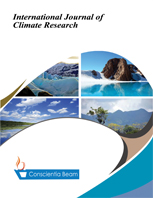Estimating the Extreme Temperature Occurrence Over Pakistan Using Interannual and Interdecadal Temperature Variation and Teleconnections During 1901-2018
DOI:
https://doi.org/10.18488/journal.112.2021.51.15.24Abstract
Temperature changes across Asia have significant impacts on human livelihoods and habitats through their impacts on drought, irrigation, water availability, vegetation, and agriculture. The spread of South Asian temperatures is characterised by a heavy seasonality across most of the subcontinent. This research focuses on the interpretation of temperatures and disturbances occurring in this part of the South Asian zone and their association with sea surface temperature (SST). Data from the Climate Research Unit (CRU) and data from the SST (1901-2018) were obtained from the National Centers for Environmental Prediction (NCEP). The findings reveal that the years from 1901 to 1945 begin to look cooler, becoming less cool as we pass into the 1950s, and rapid warming over the last few decades, both of which show the last decade to be the warmest, particularly since 1980. The findings also demonstrate that there is more warming over land than over oceans because water is slower to consume and emit heat (thermal inertia).

